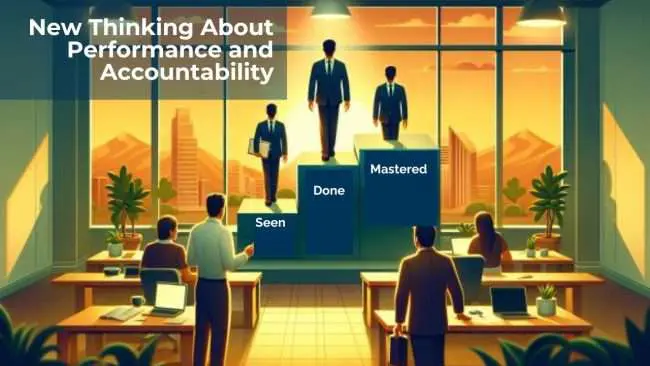Seen It, Done It, Mastered It: A New Approach to Performance Evaluation

Traditional performance reviews often feel like a dreaded annual ritual filled with vague expectations, subjective assessments, and little actionable feedback. To enhance employee Growth and organizational success, we need a more concrete, transparent, and developmental approach. Enter the “Seen It, Done It, Mastered It” framework.
Understanding the Framework
The “Seen It, Done It, Mastered It” framework is a simple yet powerful tool for defining job expectations and measuring employee performance. It’s based on the idea that employees should progressively develop their skills and abilities within their roles.
- Seen It: The employee has been trained and now has a fundamental understanding of the task or responsibility and can explain its purpose and context.
- Done It: The employee can successfully complete the task independently, meeting basic performance standards. And has done multiple repetitions. This level could be considered for advancement but should require additional time to master the work.
- Mastered It: The employee excels at the task, consistently delivers high-quality results, and can mentor or train others. They are ready for job promotion and advancement.
By applying this framework to job descriptions, managers can create clear expectations and employees can visualize their career paths.
Benefits of the Seen It, Done It, Mastered It Framework
- Clear Expectations: This framework provides a concrete way to define job roles and responsibilities. Employees know exactly what is expected of them at each stage of their development.
- Objective Evaluation: Performance assessments become more objective as managers can focus on specific behaviors and outcomes rather than subjective impressions.
- Improved Communication: Open and honest conversations about performance become easier when using clear, defined criteria.
- Enhanced Employee Development: The framework encourages a growth mindset by providing a clear path for career progression. Employees can identify their strengths and areas for improvement.
- Increased Engagement: When employees understand expectations and have a clear path for growth, they are more likely to be engaged and motivated.
Implementing the Framework
To effectively implement the “Seen It, Done It, Mastered It” framework, follow these steps:
- Revise Job Descriptions: Break down job roles into specific tasks and responsibilities. For each task, define the “Seen It,” “Done It,” and “Mastered It” levels.
- Communicate Expectations: Clearly communicate the framework to employees, explaining how it will be used to evaluate performance and support development.
- Set Goals: Develop individual development plans based on the employee’s current level of proficiency in each task.
- Provide Regular Feedback: Offer ongoing feedback and Coaching to help employees progress through the different levels.
- Recognize Achievements: Celebrate employee successes at each level to motivate and encourage continued growth.
Overcoming Challenges
Implementing any new system can be challenging. Here are some potential obstacles and solutions:
- Resistance to Change: Communicate the benefits of the framework clearly and involve employees in the process.
- Defining Levels: It may be difficult to determine specific criteria for each level. Use examples and collaborate with employees to develop clear definitions.
- Measuring Mastery: Defining mastery can be subjective. Use metrics and performance indicators to objectively assess high performance.
More on the Benefits
The “Seen It, Done It, Mastered It” (SIDMI) framework offers a multitude of advantages for both employees and organizations. Let’s explore these benefits in more detail:
Benefits for Employees
- Clear Career Path: By outlining the progression from “Seen It” to “Mastered It,” employees have a clear roadmap for their career growth. This transparency reduces ambiguity and fosters motivation.
- Increased Ownership: With a clear understanding of expectations, employees are more likely to take ownership of their roles and responsibilities. This leads to increased engagement and job satisfaction.
- Targeted Development: The SIDMI framework helps employees identify specific areas for improvement. This allows for focused development efforts and faster skill acquisition.
- Enhanced Performance Reviews: Performance discussions become more constructive and actionable when centered around specific behaviors and outcomes. Employees receive clearer feedback on their strengths and weaknesses.
Benefits for Organizations
- Improved Performance Management: The SIDMI framework provides a structured approach to performance evaluation, making it more objective and consistent across the organization.
- Enhanced Talent Development: By identifying high-potential employees who have mastered specific tasks, organizations can invest in their development and create internal talent pipelines.
- Increased Retention: Clear career paths and opportunities for growth can significantly improve employee retention rates.
- Stronger Organizational Culture: A culture of learning and development is fostered when employees are encouraged to progress through the SIDMI levels.
- Better Succession Planning: By understanding the capabilities of employees at different levels, organizations can identify potential successors for key roles.
Specific Examples of Benefits
To illustrate the benefits more concretely, let’s consider a few examples:
- Sales Representative: A sales representative who has “mastered” the art of sales can mentor new hires, leading to improved sales performance and a stronger sales team.
- Software Engineer: An engineer who has “mastered” a particular programming language can be tasked with leading complex projects or training colleagues.
- Customer Service Representative: A representative who has “mastered” handling difficult customer inquiries can be promoted to a customer service supervisor or become a subject matter expert.
Conclusion
The “Seen It, Done It, Mastered It” framework offers a fresh perspective on performance evaluation and employee development. By focusing on specific behaviors and outcomes, organizations can create a more transparent, fair, and effective performance management system. This approach empowers employees to take ownership of their career growth while aligning their development with organizational goals. By embracing this framework, you can foster a culture of continuous improvement and high performance.
Would you like to explore specific examples of how to apply this framework to different job roles or industries?
The post Seen It, Done It, Mastered It: A New Approach to Performance Evaluation appeared first on Business Advisor and Executive Coach | Doug Thorpe.
























